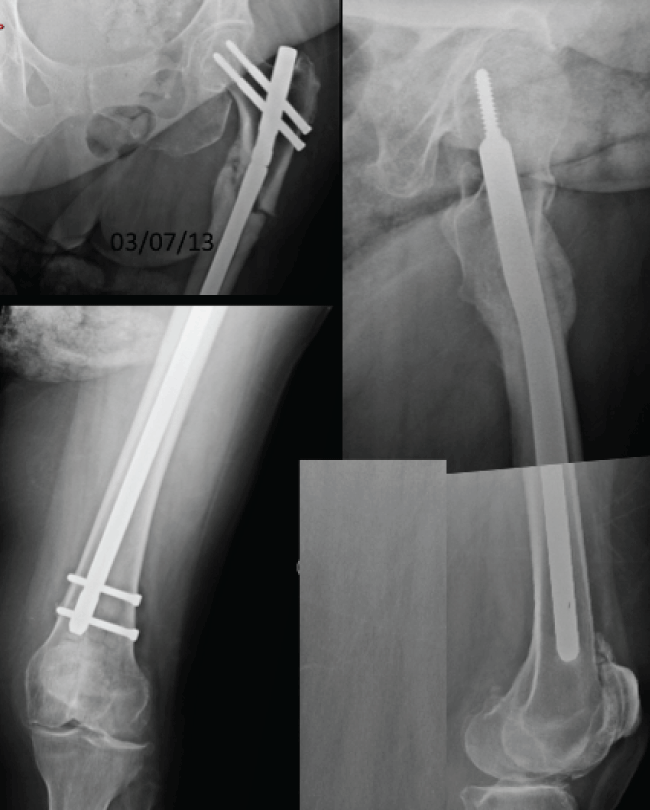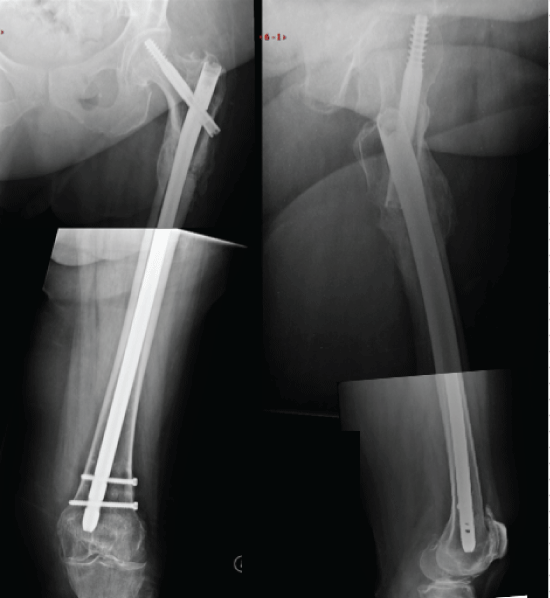Trauma Cases and Reviews
Surgical Management of an Atypical Femoral Non-Union Fracture with Bone Morphogenic Protein Supplementation
Jike Lu* and Masumi Maruo Holledge
Department of Orthopaedics, Beijing United Family Hospital, China
*Corresponding author:
Jike Lu, Department of Orthopaedics, Beijing United Family Hospital, 2 Jiangtai lu, Chaoyang District, Beijing, 100016, China, Tel: +86-5927-7000, Fax: +86-5927-7407, E-mail: 13911095602@163.com
Trauma Cases and Reviews, TCR-3-048, (Volume 3, Issue 1), Case Report; ISSN: 2469-5777
Received: June 30, 2016 | Accepted: February 20, 2017 | Published: February 23, 2017
Citation: Lu J, Maruo Holledge M (2017) Surgical Management of an Atypical Femoral Non-Union Fracture with Bone Morphogenic Protein Supplementation. Trauma Cases Rev 3:048. 10.23937/2469-5777/1510048
Copyright: © 2017 Lu J, et al. This is an open-access article distributed under the terms of the Creative Commons Attribution License, which permits unrestricted use, distribution, and reproduction in any medium, provided the original author and source are credited.
Abstract
This is a case report of a surgical treatment of the non-union of an atypical femoral fracture (AFF), associated with prolonged bisphosphonate use. The case is one of a subtrochanteric non-union and implant failure, after an index procedure of a trochanteric entry-point-locked cephalomedullary nailing. The non-union fracture healed successfully by exchange of nail and autologous iliac crest bone graft and a bone morphogenic protein-7 (osteogenic protein-1, OP-1) supplementation.
This case describes one of the surgical treatment options for treating non-union with implant failure in AFF treatments. The case suggests that the surgical management of bisphosphonate-related AFFs should be different from standard fracture treatment: for example involving a thicker and longer intramedullary (IM) nail, an autologous iliac crest bone graft, and use of bone morphogenic proteins.
Keywords
Atypical femoral fractures, Hip fractures/surgery, Bisphosphonate, Non-union, OP-1
Introduction
The overall incidence of non-union or delayed union of subtrochanteric fractures, and subsequent failure of fixation, regardless of type, varies from 7% to 20% [1]. This case report provides one of the surgical treatment options for treating non-union with implant failure, for patients with AFF associated with bisphosphonate use. The optimizations of the mechanical environment (revision of fixation), along with the enhancement of the multidimensional biological pathways of bone healing, was used as the framework for a single stage surgical revision for atrophic non-union with implant failure in the AFF case.
Case Report
An 87-year-old female had a left upper frontal thigh pain with a sudden onset of pain in her hip. She had been unable to bear weight for 18 months previously, but with no history of falls or injuries. She has a co-morbidity including diabetes mellitus, and was on medications. She had been on a bisphosphonate (alendronate) for the previous ten years. Her initial radiographs were performed in a different hospital (with no radiographs available). She was diagnosed as AFF based on an ASBMR task force 2013 revised case definition of AFF [2].
The index IM nail insertion was performed in the first hospital. A piriformis entry-point-locked cephalomedullary nailing was used (Figure 1), and the patient was allowed weight bearing as tolerated, at six weeks after surgery. She reported that there was no pain on mobilization with the assistance of a four-wheel frame walker, post surgery. However, twelve months after surgery, she developed upper thigh pain and difficulty in walking. The radiographs showed an atrophic non-union fracture with the breakage of an IM nail at the level of the non-union fracture site. However, we noted that there was no breakage in the distal locking screws. This differed from the usual patterns of IM failure (Figure 1). Twelve months after initial management, revision surgery was performed with the removal of the broken implants, and re-insertion of a longer and thicker nail, plus an autologous iliac crest bone graft, and OP-1 supplementation at the fracture site. The patient was allowed weight bearing as tolerated, immediately after surgery. At nine months post revision surgery, complete healing was achieved (Figure 2).

.
Figure 1: 12 months post index IM nailing the radiographs showed subtrochanteric fracture of the proximal femur with small oblique fracture line and cortices thicken on AP and lateral views. Breakages IM nail at the non-union site with intact distal locking screws were clearly demonstrated on AP view.
View Figure 1

.
Figure 2: Twelve months after initial index surgery, removal of broken implants, re-insertion of longer and thicker long Gamma nail with autologous iliac crest bone graft and supplement of the OP-1 were performed. Nine months post revision surgery, radiographs showed complete healing of the fracture with pain-free on full weight bearing.
View Figure 2
Discussion
A growing number of case reports and epidemiological data suggest an association between bisphosphonate use and atypical subtrochanteric and femoral shaft fractures, and moreover that longer treatment is associated with higher risk [2]. Bisphosphonate-associated AFFs are rare compared with osteoporotic fractures [2]. For that reason, treatment options for AFFs are largely still under discussion.
There is strong supportive evidence that AFFs, as stress or insufficiency fractures, differ from osteoporosis fractures, as in our case, in which the patient didn't have a history of falls or injuries [2]. AFFs have radiographic features that are characteristically transverse or slightly oblique in nature, and occur in the lateral cortex, or tension side, of the subtrochanteric region of the femur, where diffuse cortical thickening and fractures can be observed on radiographs. The most dependable radiographic characteristics for identifying AFFs are focal lateral cortical thickening and a transverse fracture line [3]. Complete fractures tend to have a characteristic radiographic appearance, as in our case (Figure 1).
Within the femur, the subtrochanteric region experiences larger compressive and tensile forces than the other regions of this long bone. These forces can reach several times that of body weight [4]. In the presence of bisphosphonates, bone remodelling is suppressed and increased micro-damage accumulation leads to deterioration in the micro-architecture of the bone [5]. This remodelling suppression of bone material properties can lead to increased AFFs, as well as influencing recovery [6]. The bisphosphonate-related suppression of bone remodelling may slow healing and prolong the path to recovery. The inhibitory effect of bisphosphonates on osteoclastic remodelling decreases intra-membranous fracture healing, and may lead to increased rates of delayed union (or non-union).
The number of fractures prevented by bisphosphonate use far exceeds those potentially related to bisphosphonate therapy [7]. However, the increasing number of delayed or non-union AFFs is an important concern for either index or revision surgery. Clinical literatures have raised concern about the appropriate length of bisphosphonates treatment [7]. It is known that bisphosphonates, particularly alendronate, have long-term biologic effects [8]. Even when the drug is discontinued, the physiologic effects persist for at least a further five years [8]. Anti-fracture efficacy is limited in postmenopausal osteoporosis beyond five years [8]. Bisphosphonate treatment should include a drug holiday after five years administration. Also following the diagnosis of a complete or impending AFF, discontinuation of bisphosphonates should be recommended to help promote a more favorable healing environment [9].
A multi-disciplinary approach, incorporating both medical and surgical teams, should be used for bisphosphonate-associated fractures. Augmented fracture fixation by supplementation of a biological agent may be a reasonable approach, for initial and revision surgery. We suggest that the preferred treatment method could include surgical stabilizations, with supplementary bone-healing treatments such as autologous iliac crest bone graft, and or bone morphogenic protein such as OP-1, in order to get simultaneous optimization of the mechanical and biological environment. Over the past decade, many studies have reported the use of OP-1 for non-union treatment [10], but as far as we know this is the first report of OP-1 usage for a non-union AFF case. Although further studies are needed to confirm efficacy for AFFs, management of non-union AFF with implant failure, with exchange intramedullary nail and autogenous bone graft in addition to the supplement of OP-1, is an option during the surgical decision-making process.
References
-
de Vries JS, Kloen P, Borens O, Marti RK, Helfet DL (2006) Treatment of sub- trochanteric nonunions. Injury 37: 203-211.
-
Shane E, Burr D, Abrahamsen B, Adler RA, Brown TD, et al. (2014) Atypical subtrochanteric and diaphyseal femoral fractures: second report of a task force of the American Society for Bone and Mineral Research. J Bone Miner Res 29: 1-23.
-
Rosenberg ZS, La Rocca Vieira R, Chan SS, Babb J, Akyol Y, et al (2011) Bisphosphonate-related complete atypical subtrochanteric femoral fractures: Diagnostic utility of radiography. AJR Am J Roentgenol 197: 954-960.
-
Haidukewych GJ (2010) Subtrochanteric fractures. In: Bucholz RW, Heckman JD, Tornetta P, Rockwood and Green's Fractures in Adults. (7th edn), Lippincott Williams and Wilkins, Philadelphia, USA, 1641-1654.
-
Dobnig H, Stepan JJ, Burr DB, Li J, Michalská D, et al. (2009) Teriparatide reduces bone microdamage accumulation in postmenopausal women previously treated with alendronate. J Bone Miner Res 24: 1998-2006.
-
Edwards BJ, Bunta AD, Lane J, Odvina C, Rao DS, et al. (2013) Bisphosphonates and nonhealing femoral fractures: Analysis of the FDA Adverse Event Reporting System (FAERS) and international safety efforts. A systematic review from the Research on Adverse Drug Events And Reports (RADAR) project. J Bone Joint Surg Am 95: 297-307.
-
Wang Z, Bhattacharyya T (2011) Trends in incidence of subtrochanteric fragility fractures and bisphosphonate use among the US elderly: 1996-2007. J Bone Miner Res 26: 553-560.
-
Schneider JP (2009) Bisphosphonates and low- impact femoral fractures: Current evidence on alendronate-fracture risk. Geriatrics 64: 18-23.
-
Shane E, Burr D, Ebeling PR, Abrahamsen B, Adler RA, et al. (2010) American Society for Bone and Mineral Research: Atypical subtrochanteric and diaphyseal femoral fractures: Report of a task force of the American Society for Bone and Mineral Research. J Bone Miner Res 25: 2267-2294.
-
Friedlaender GE, Perry CR, Cole JD, Cook SD, Cierny G, et al. (2001) Osteogenic protein-1 (bone morphogenetic protein-7) in the treatment of tibial nonunions. J Bone Joint Surg Am 83: S151-S158.





